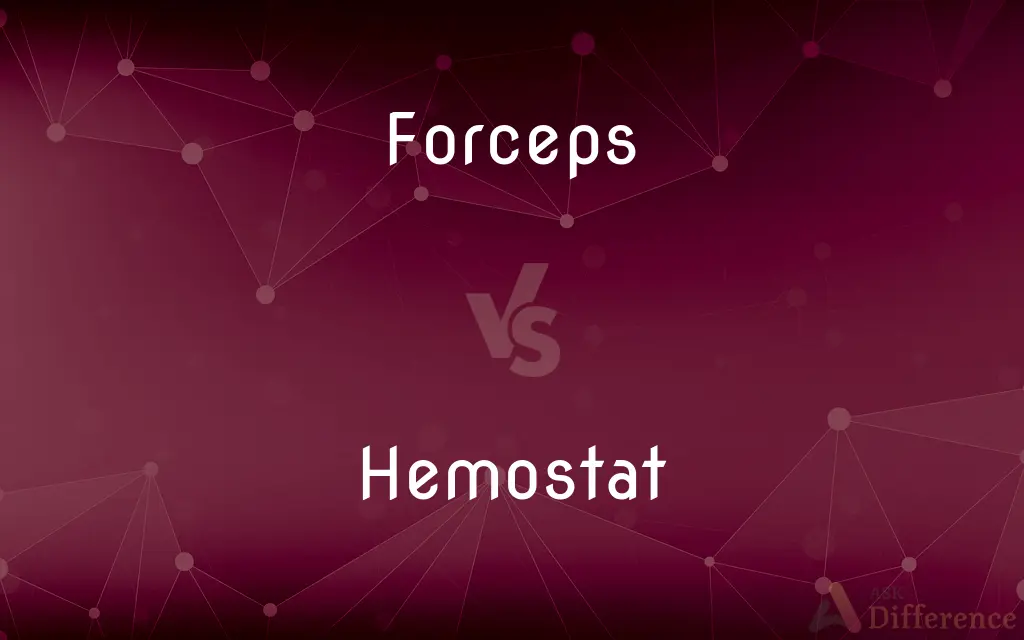Forceps vs. Hemostat — What's the Difference?
By Fiza Rafique & Maham Liaqat — Updated on April 2, 2024
Forceps are tweezers-like tools used for gripping, holding, and manipulating tissues or objects in medical procedures, while hemostats are clamp-like devices designed specifically to control bleeding by constricting blood vessels.

Difference Between Forceps and Hemostat
Table of Contents
ADVERTISEMENT
Key Differences
Forceps function similarly to tweezers, providing precision and control when manipulating tissues, removing foreign objects, or assisting in suturing during medical and surgical procedures. They come in various shapes and sizes, tailored to specific tasks, including but not limited to gripping, holding, and moving delicate tissues. On the other hand, hemostats, also known as hemostatic clamps, are specialized surgical instruments used primarily to stop bleeding. They achieve this by applying pressure to blood vessels, effectively clamping them shut, and are essential in surgeries to maintain a clear view of the operative field and to minimize blood loss.
While forceps are versatile tools used across a wide range of medical and surgical disciplines, hemostats have a more focused application in controlling hemorrhage. Whereas forceps can have smooth or toothed ends depending on the application, hemostats typically feature locking mechanisms that allow them to remain securely closed over blood vessels without continuous manual pressure, highlighting their specialized design for blood vessel compression.
The design of forceps emphasizes grip and precision, with variations like alligator forceps featuring long, narrow jaws for reaching into small areas, and others having broader tips for grasping larger tissues. Conversely, hemostats are designed with serrations and a locking mechanism, which are critical for their role in clamping and holding blood vessels or tissues until bleeding is controlled or stopped.
Forceps and hemostats are both critical in the medical field for their respective roles in surgery and tissue manipulation. Forceps are indispensable for their wide applicability in handling tissues and surgical materials, while hemostats are vital for their life-saving ability to control bleeding during procedures.
The distinction between forceps and hemostats highlights the diversity and specialization of tools in medical practice, with each instrument tailored to meet specific needs of medical professionals in patient care and surgical procedures. This specialization ensures that surgeries and medical treatments can be carried out with the highest level of efficacy and safety.
ADVERTISEMENT
Comparison Chart
Primary Use
Gripping, holding, and manipulating tissues or objects
Controlling bleeding by clamping blood vessels
Design
Varied designs for specific tasks, with smooth or toothed ends
Typically features a locking mechanism and serrated jaws
Application
Broad use across medical and surgical disciplines
Focused on stopping bleeding during surgical procedures
End Tip Variations
Smooth, toothed, or specialized shapes for specific tasks
Serrated edges designed for gripping blood vessels securely
Locking Mechanism
Usually non-locking, designed for temporary grip
Locking design to maintain pressure without continuous manual force
Compare with Definitions
Forceps
Surgical tool for gripping and manipulating tissues.
The surgeon used forceps to carefully remove the splinter.
Hemostat
Features a locking mechanism.
Once positioned, the hemostat's lock was engaged to keep the vessel clamped.
Forceps
Comes in various shapes for specific tasks.
Alligator forceps are used for reaching into narrow spaces.
Hemostat
A clamp-like device for controlling bleeding.
The doctor used a hemostat to stop the bleeding from the artery.
Forceps
Can have smooth or toothed ends.
Toothed forceps provide a better grip on slippery tissues.
Hemostat
Has serrated jaws for gripping.
The hemostat's serrated jaws securely grasped the bleeding vessel.
Forceps
Designed for precision and control.
The fine-tipped forceps allowed for delicate tissue manipulation.
Hemostat
Used primarily in surgeries.
Hemostats were essential in maintaining a clear view during the procedure.
Forceps
Essential in surgical and medical procedures.
Forceps held the sutures in place during the operation.
Hemostat
Specialized for blood vessel compression.
The curved hemostat was placed around the vessel to control hemorrhage.
Forceps
Forceps (plural forceps or considered a plural noun without a singular, often a pair of forceps; the Latin plural forcipes is no longer recorded in most dictionaries) is a handheld, hinged instrument used for grasping and holding objects. Forceps are used when fingers are too large to grasp small objects or when many objects need to be held at one time while the hands are used to perform a task.
Hemostat
A hemostat (also called a hemostatic clamp, arterial forceps, or pean after Jules-Émile Péan) is a surgical tool used in many surgical procedures to control bleeding. For this reason, it is common in the initial phases of surgery for initial incision to be lined with hemostats which close blood vessels awaiting ligation.
Forceps
An instrument resembling a pair of pincers or tongs, used for grasping, manipulating, or extracting, especially such an instrument used by a surgeon.
Hemostat
An agent, such as a chemical, that stops bleeding.
Forceps
A pincerlike pair of movable appendages at the posterior end of the abdomen in certain insects, such as earwigs.
Hemostat
A clamplike instrument used to compress a blood vessel in order to reduce or arrest the flow of blood during surgery.
Forceps
An instrument used in surgery or medical procedures for grasping and holding objects, similar to tongs or pincers.
Hemostat
(medicine) An instrument that clamps blood vessels to diminish or halt blood flow.
Forceps
A pair of pinchers, or tongs; an instrument for grasping, holding firmly, or exerting traction upon, bodies which it would be inconvenient or impracticable to seize with the fingers, especially one for delicate operations, as those of watchmakers, surgeons, accoucheurs, dentists, etc.
Hemostat
A surgical instrument that stops bleeding by clamping the blood vessel.
Forceps
The caudal forceps-shaped appendage of earwigs and some other insects. See Earwig.
Hemostat
A surgical instrument that stops bleeding by clamping the blood vessel
Forceps
An extractor consisting of a pair of pincers used in medical treatment (especially for the delivery of babies)
Common Curiosities
Can forceps be used to control bleeding?
While forceps can manipulate tissues, hemostats are specifically designed for controlling bleeding through vessel compression.
Is the locking mechanism present in all hemostats?
Most hemostats have a locking mechanism to maintain pressure on a blood vessel without continuous manual force.
What is the main difference between forceps and hemostats?
Forceps are used for gripping and manipulating tissues or objects, while hemostats are specialized tools designed to control bleeding by clamping blood vessels.
Are there different types of forceps?
Yes, there are many types of forceps, including alligator, needle, and tissue forceps, each designed for specific tasks.
Are there specialized forceps for specific surgeries?
Yes, there are specialized forceps designed for particular types of surgery, such as ophthalmic forceps for eye surgery.
How are hemostats cleaned and sterilized?
Hemostats are cleaned and sterilized through processes like autoclaving to ensure they are safe for reuse in medical procedures.
How do hemostats stop bleeding?
Hemostats stop bleeding by applying pressure to blood vessels, clamping them shut to prevent blood flow.
How do surgeons choose between using forceps or a hemostat?
The choice depends on the task at hand; forceps are chosen for gripping and manipulating, while hemostats are used for controlling bleeding.
Can hemostats be used on all sizes of blood vessels?
Hemostats come in various sizes to accommodate different sizes of blood vessels, from small capillaries to larger arteries.
Why are forceps important in surgery?
Forceps provide the precision and control needed to manipulate tissues and materials during surgery, ensuring accurate and safe procedures.
Do all forceps have teeth?
No, forceps can have smooth or toothed ends, depending on their intended use.
What is the significance of the design variations in forceps and hemostats?
Design variations ensure that each tool can perform its specific function effectively, whether it's manipulating delicate tissues or controlling bleeding.
Can forceps cause tissue damage?
If not used carefully, especially toothed forceps, they can damage tissues, which is why precision and the correct choice of forceps are crucial.
What makes hemostats different from regular clamps?
Hemostats are designed for medical use with features like serrated jaws and locking mechanisms suited for controlling bleeding in surgical settings.
How do hemostats contribute to patient safety?
By effectively controlling bleeding, hemostats help maintain a clear surgical field and minimize blood loss, contributing to patient safety.
Share Your Discovery

Previous Comparison
Heteronym vs. Homonym
Next Comparison
Range vs. ScaleAuthor Spotlight
Written by
Fiza RafiqueFiza Rafique is a skilled content writer at AskDifference.com, where she meticulously refines and enhances written pieces. Drawing from her vast editorial expertise, Fiza ensures clarity, accuracy, and precision in every article. Passionate about language, she continually seeks to elevate the quality of content for readers worldwide.
Co-written by
Maham Liaqat















































